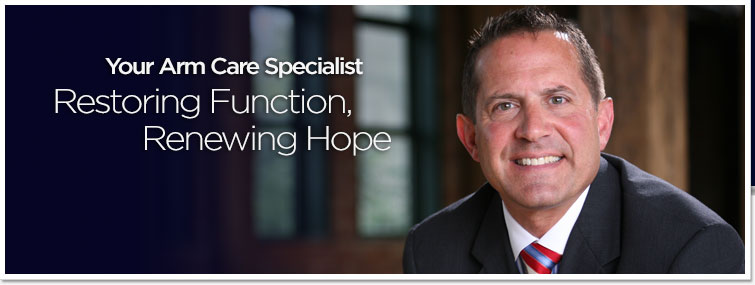NOTICE:
Our Practice has MOVED
Our new location is:
Suite 405
1815 South Clinton Ave
Rochester, NY, 14618.
The NEW phone number is 585-565-3500
Our Practice has MOVED
Our new location is:
Suite 405
1815 South Clinton Ave
Rochester, NY, 14618.
The NEW phone number is 585-565-3500

For appointments call
585.565.3500
Fax Number:
585.434.4081
585.565.3500
Fax Number:
585.434.4081

Clinical Update: Rotator Cuff Arthropathy
July 21st, 2008
When one has impaired shoulder function and pain due to either an irreparable rotator cuff tear, rotator cuff arthropathy (arthritis secondary to a chronic rotator cuff tear) or osteoarthritis associated with a rotator cuff tear, Hemiarthroplasty and Reversed Shoulder Arthroplasty are the two contemporary treatment options. When the coracoacromial arch is intact—that is—there is no anterior superior escape of the humeral head, flexion ≥ 90º is typically possible. Interestingly, Goldberg et al noted in “Hemiarthroplasty for the Rotator Cuff-deficient Shoulder” (J Bone Joint Surg 2008; 90:554-559) that this is still a very efficacious option in patients regardless of age, gender or previous surgery so long as preoperative forward elevation is ≥ 90º. When shoulder forward elevation is ≤ 90º, however, Reversed Arthroplasty is a better alternative, and although complications use to approximate 50%, the outcomes using current designs and techniques are more reliable, with complication rates approximating 13% for after primary surgery and 37% for revision surgery (Wall B et al J Bone Joint Surg 2007;89: 1476-85).
Glenosphere fixation has been the subject of recent investigation to diminish the risk of loosening and scapular notching, the latter of which has been associated with poorer outcomes at intermediate follow-up ( Simovich RW et al J Bone Joint Surg 2007; 89: 588-600). Tom Norris and his co-authors, in two separate papers ( J Shoulder Elbow Surg 2008 589-601), suggest that the central peg of the glenosphere baseplate should be placed 12 mm above the unreamed inferior glenoid rim—with optimal fixation within 3 columns: the base of the coracoid, the scapular spine, and the scapular pillar.
Lastly, in an effort to improve the external rotation that is often lacking after Reversed arthroplasty, the legendary Christian Gerber and co-authors have recommended, based on a biomechanical study, a concomitant transfer of the latissimus dorsi to an insertion site on the posterior side of the greater tuberosity, adjacent to the teres minor insertion (J Shoulder Elbow Surg 2008;17: 650-58).
For more information regarding these options see the Shoulder section of this website or email me by going to the Contact Dr Tomaino section.
Replies
No replies!



